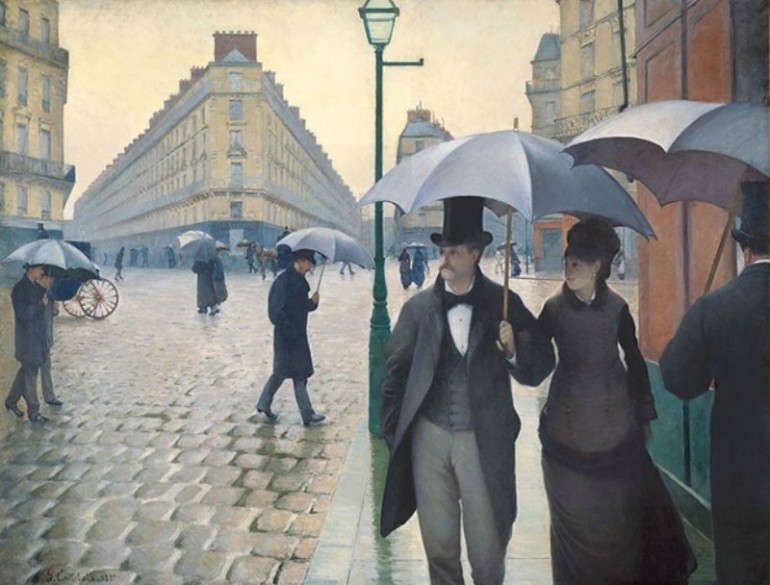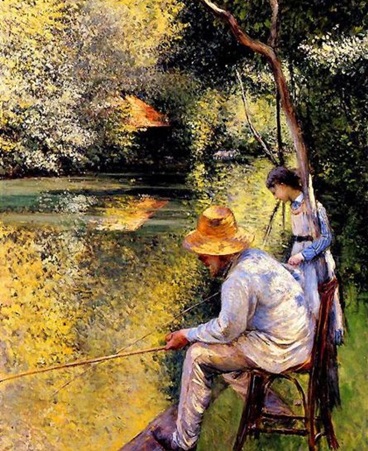French painter Gustave Caillebotte was born on August 19, 1848. He was an Impressionist painter whose style leaned more toward Realism. His family was Parisian upper class. His father was a Seine department’s Tribunal de Commerce judge and inheritor of the family’s military textile business. By the time Caillebotte was 12 years old he spent his summers with his family in Yerres where his father bought a large property and built a summer home. At around that time Caillebotte also started painting and drawing.
Gustave Caillebotte did not start out as an artist. In 1868 he earned a law degree and acquired a license in 1870 to practice law. He also had a degree in engineering. He served in the Garde Nationale Mobile de la Seine from July 1870 until March 1871 during the Franco-Prussian war.
Professional Life
It was after the war that his earlier interest in painting resurfaced. He visited the studio of French painter and portraitist Léon Bonnat, from whom he took painting lessons in all seriousness. He had a talent for art and was able to develop his own personal style very shortly and built his first studio at the home of his parents. While he attended the École des Beaux-Arts in 1873, he missed many classes. He was a landed gentry after all, inheriting his father’s fortune in 1874 at which time he met and became friends with several artists outside of the academy such as Italian Impressionist painter Giuseppe de Nittis and Edgar Degas. He was one of the founders of Impressionism but would rather be called a Realist painter.
Caillebotte attended the Impressionist exhibition in 1874 with his newfound friends and debuted in the 1876 Impressionist exhibition at the Salon. He showcased eight paintings in his first exhibition, including the stark and vivid chiaroscuro-like “The Floor Scapers” (Les raboteurs de parquet) that he did in 1875. When he first presented this painting to the Salon, it was rejected and considered vulgar, which showed shirt-less laborers scraping the floors. The critics at the Salon only viewed rustic peasants and farmers as the accepted working class subjects. He did include another version of The Floor Scrapers, showing only two men, showing the floor with a shiny veneer, reflecting the light coming from the open window. The second version showed a more realistic style that was similar to the style of Degas, which showed the artist’s range of technique. Another painting he included was “Young Man at His Window (Jeune homme à sa fenêtre). This was a painting of his brother Martial, standing at the balcony of their home looking out to the scene at Boulevard de Malesherbes. Some critics were not particularly fond of the painting saying that it was too much like a photograph, an art form that interested Caillebotte.
The first version (original) of “The Floor Scrapers” now hangs at the Musée d’Orsay since 1986. It was given to the Musée du Luxembourg by the family of the artist in 1894 and was transferred in 1929 to the Musée du Louvre.
Style
Although Caillebotte was strongly influenced by several Impressionist artists who became his close associates, Realism was his style. He, like Gustave Courbet and Jean-François Millet intended to paint reality as he viewed it, to reduce the artificial staginess of paintings in general.
His style was not definitive though, perhaps because of his close association with different artists, thus he was always in the crux of experimenting and borrowing. He exhibited the realistic rich colors of Degas particularly in his interior scenes although at other times his works showed the loose brush strokes and pastel softness of Impressionist painters like Camille Pissarro and Pierre-Auguste Renoir.
Characteristic of Gustave Caillebotte’s paintings was the tilted ground, thought to be influenced by the zooming in and cropping in photography and by Japanese prints, although it could also be due to Caillebotte deep interest in various perspective effects. There were several paintings of his that employed a very high vantage point.
Recurring Themes
A prolific painter, Caillebotte created portraits, interior and familial and domestic scenes, most of which showed his family members, and often showing his quiet observance of an upper-class family’s life.
His en plein air paintings were focused on their time at their summer house at Yerres, using a softer technique employed by Impressionists such as Renoir, which contrasted with the smoother and flatter brush strokes he used for his paintings of urban scenes. He was also highly known for his paintings of scenes of urban Paris. Food was the primary focus of his still life paintings and he showed his versatility by painting some nudes as well, but nothing mythological or erotic.
With his sizeable personal wealth, he was not pressured to sell his paintings. He used his wealth to fund exhibitions of his Impressionists colleagues and buying the works of his friends and fellow artists including Camille Pissarro, Auguste Renoir and Claude Monet. He was known to have paid for the rent of studios of other artists, just like what he did for Claude Monet.
In his will, a large part of his collection was to be donated to the French government, with Renoir as executor, but stipulated that these be displayed at the Luxembourg Palace, since he realized that the Impressionists were not yet accepted in France.
In 1896, after much negotiation, the government was to get 68 paintings created by Édouard Manet, Paul Cézanne, Edgar Degas, Alfred Sisley, Pierre-Auguste Renoir, Claude Monet and Camille Pissarro. The French government did not agree to the stipulation. Thirty-eight of the paintings were brought to Luxembourg Palace and later to the Louvre. Renoir took one of the paintings as this will executor’s fee and the remaining 29 were again offered to the French government in 1904 and in 1908. The government finally wanted to claim the paintings in 1928 but Martial Caillebotte’s widow repudiated the bequest. The paintings were eventually purchased by Albert C. Barnes.
Photo Attribution:
Featured and 1st image by Gustave Caillebotte [CC-BY-SA-3.0 (http://commons.wikimedia.org/wiki/File:Gustave_Caillebotte_-_Jour_de_pluie_%C3%A0_Paris.jpg)], via Wikimedia Commons
2nd image by Gustave Caillebotte [CC-BY-SA-3.0 (http://commons.wikimedia.org/wiki/File:G._Caillebotte_-_P%C3%AAcheur_au_bord_de_l%27Yerres.jpg)], via Wikimedia Commons

